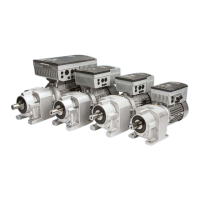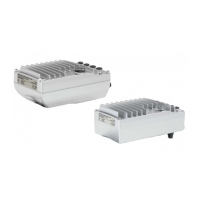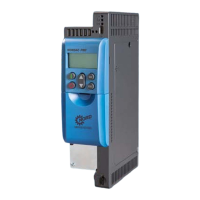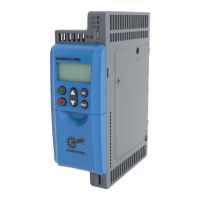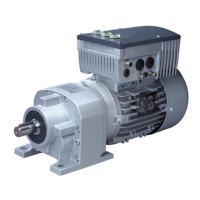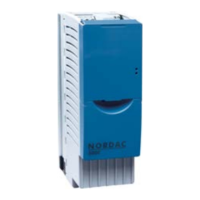POSICON positioning control – Supplementary manual for series SK 200E and SK 250E-FDS
26 BU 0210 en-3117
The number of revolutions of the encoder are converted into the number of motor revolutions in the
frequency inverter with the aid of the parameters P607 "Speed ratio" and P608 "Reduction ratio.
n
M
= n
G
* Ü
b
/ U
n
n
M
: Number of revolutions of motor
n
G:
: Number of revolutions of encoder
Ü
b
: Speed ratio
(P607 [-01])
U
n
: Reduction ratio
(P608 [-01])
Example
The encoder is installed on the output side of the gear unit. The gear unit has a speed ratio of i = 26.3.
The following values are parameterised:
P607 [-01] =
263
P608 [-01] =
10
The direction of rotation of the encoder must be the same as the direction of rotation of the motor. With a positive
output frequency (clockwise rotation) the actual position value must increase. If the direction of rotation is not
correct, this can be adjusted with a negative value in P607 "Speed Ratio".
With the aid of a value which can be parameterised in parameter P609 [-01]] "Offset Position" the zero
point can be set to a different position to that which is determined by the reference point. The offset is
applied after conversion of the encoder rotations to motor rotations. After changes to the speed
ratio/reduction ratio (P607 [-01] and P608 [-01]) the offset position value must be entered again.
Pos: 12 2 /Anlei tung en/El ektr onik/P OSICON /4. Funkti onsbes chr eibung/ Refer enz punktf ahrt @ 1 4\mod_1478013480398_388.docx @ 2299593 @ 4 @ 1
4.2.1.1 Approach reference point
The reference point run is started via one of the digital inputs or one of the Bus IO In bits. For this, a
digital input (P420…) or a bus IO In Bit (P480…) must be set to the corresponding function (Function
22). The direction of the reference point search is specified via the signals "Enable Left/Right". The
current setpoint frequency determines the speed of the reference point run. The reference point is also
read in via one of the digital inputs or the Bus IO In bits (setting 23).
A prerequisite for control via Bus IO bits is that the function 20 is assigned to a bus setpoint (P546…).
Sequence of the reference point run
With the reference point run enabled, the drive unit moves in the direction of its setpoint value (Enable
Right/Left, +/- Setpoint). On reaching the reference point switch, the signal at the digital input or Bus
IO In Bit "Reference Point" reverses the direction of travel. Therefore the drive unit moves away from
the reference switch again.
If the drive unit is already at the switch at the start of the reference point run, the reference point run is
immediately started with the inverse direction of rotation.
After leaving the switch, the actual position is set to the value which is set in parameter P609 "Offset
Position". If this value is not "0" the drive unit immediately moves to its new zero point. The drive unit
remains at this point until the "Reference point run" signal is removed. If relative positioning (Function
1) is selected in parameter P610 the set position is simultaneously set to the value 0.
The feedback from the frequency inverter for the completion of the reference point run with adoption of
a valid reference point can also be made via a digital signal. For this, a digital output (P434 …) or a
bus IO bit (P481…) must be set to function 20.
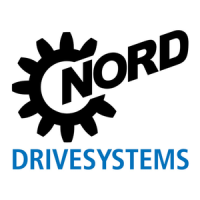
